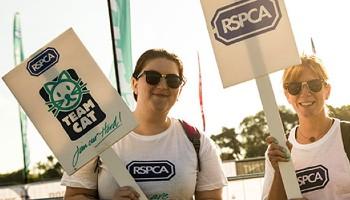Fish behaviour and needs
We believe that fish have the mental capacity to feel pain and suffer and that their welfare should be safeguarded in the same way as that of any other farmed animal.
There's increasing evidence that fish in general are more sentient (capable of sensing and feeling things) than many people think. In scientific studies, it's been shown that many fish species:
- have good memories
- are capable of learning and remembering fairly complicated tasks
- can learn from the actions of other fish.
Fish farming in the UK
Many species of fish are used in aquaculture and may be farmed in both freshwater and seawater. They're produced in a variety of systems, ranging from closed systems, where the water is artificially re-circulated, to open systems where the fish are contained in more natural bodies of water, such as a pond or sea enclosure. Here's more on how salmon farming works in the UK.
Farming of Atlantic salmon
Atlantic salmon is the most commonly farmed fish species in the UK, with farms mainly located in the Scottish Highlands and Islands. There are freshwater and seawater stages to their lives.
- Freshwater stage – fertilised salmon eggs are usually grown in trays. The eggs hatch into 'alevins' or 'yolk sac fry' and spend time on the bottom of their trays until their yolk sac has been absorbed. They then start to rise up into the water column as 'first feeding fry', before being transferred to larger tanks or freshwater lochs. They spend a significant time in freshwater before they're ready to go to sea.
- Seawater stage – when they’re six to 12 months old, the fish begin to adapt so they can cope in a seawater environment ('smoltification'). The salmon will then be reared in seawater enclosures for the next one to two years.
- End of production – once salmon have reached the desired weight, they are removed from their enclosure and slaughtered.
Transportation
The most common ways of transporting fish are by road, boat or helicopter. One method is ‘wellboats’, where the fish are carried in a specially designed well in the hold of the boat. The water quality in the wellboats can be controlled and underwater cameras monitor the fish.
Farmed fish welfare
Here are some of our key concerns about the welfare of farmed fish in the UK.
Water quality
The quality of water (its temperature, pH, oxygen levels, etc.) has a big impact on fish welfare. Different fish species survive better in different conditions.
We believe more work is needed on aspects of water quality such as carbon dioxide levels, which can impact fish welfare if they're too high. Increasing the water temperature when the fish are small can make them grow more quickly, but if fish grow too fast during this time they can end up with spinal deformities.
Handling procedures
Farmed fish are sometimes handled, for example when they're being vaccinated or graded according to their size. These procedures can be stressful for the fish, especially if they're taken out of the water. It's essential to keep handling to an absolute minimum.
Stocking densities
Stocking density is the weight of fish kept in a given volume of water. Research and practical experience has shown that – on its own – stocking density isn't necessarily one of the most important things affecting fish welfare. Some fish seem to prefer a higher stocking density, while others prefer a lower density. Stocking densities that are too low can cause certain species of fish to become territorial and aggressive towards each other.
Transport
All transport, whether by road, boat or helicopter, can be potentially stressful for the fish.
Extra attention is needed during transport, particularly when the fish are loaded and unloaded. It's also essential to be able to maintain the correct water quality for the whole length of the journey, especially if delays or emergencies make the journey much longer than expected.
Slaughter
There are a number of slaughter methods used in aquaculture. We believe that the only methods of slaughter that are acceptable in terms of animal welfare for Atlantic salmon and rainbow trout are percussive stunning followed by bleeding, and electrical stunning.
- Percussive stunning is when a blunt object is used to destroy the brain of an animal. It renders them unconscious, but can also cause immediate death. In aquaculture, this is followed by bleeding to ensure the animal dies. Our welfare standards require automated devices to be used for stunning as these ensure a more consistent blow.
- Electrical stunning, when used correctly, can either cause a fish to lose consciousness before they are killed through bleeding (most common in larger fish, above 2kg) or cause immediate death (most common in small fish, less than 1kg).
- Methods such as the use of carbon dioxide, suffocation in air or on ice, and bleeding the fish without stunning, are all unacceptable on animal welfare grounds.
Improved farmed fish welfare
We're working to increase awareness of fish welfare issues and engaging with the salmon and trout farming industries, governments and retailers to encourage better fish welfare. Here are some of the things we're doing.
Developing welfare standards
We've developed a set of detailed welfare standards for farmed Atlantic salmon and farmed rainbow trout. These cover the key areas affecting fish welfare, including water quality, stocking density, handling, health, slaughter and wider environmental impact.
We've also written what we believe are the world's first welfare standards for wellboats and cleanerfish.
Working with the fish farming industry
We take every opportunity to engage with decision makers in the fish farming industry and to put forward our views to encourage better welfare for farmed fish. We also regularly engage with other NGOs, governments and other stakeholders to advocate for improvements to fish welfare. For example, we were part of the British Veterinary Association working group for developing their policy position paper on Sustainable Finfish Aquaculture. In the past, we've been part of many other working groups to develop industry standards, consult on policy changes and provide unbiased and factually correct feedback.
Scientific research
We've conducted our own applied research looking at how freshwater stocking densities affect fish welfare. We're also developing a welfare outcome assessment to make it easier to tell whether fish welfare on a given farm is as good as possible or could be improved.
How you can improve the welfare of farmed fish
Here's how you can do your bit to help improve the welfare of farmed fish in the UK. If more consumers insist on higher welfare products, more supermarkets will want to stock them, which will encourage more farmers to improve their farming practices. Ultimately, more farmed fish will benefit.
Looking for the RSPCA Assured label
If you eat salmon or trout and you're concerned about farmed fish welfare, look for products carrying the RSPCA Assured logo. RSPCA Assured is our farm assurance and food labelling scheme, which aims to ensure that animals are reared, handled, transported and slaughtered according to our strict welfare standards. Here’s where you can buy RSPCA Assured labelled food.
Join our campaigns
Please support our campaigns to improve the welfare of as many farm animals as possible, at every stage of their lives.



